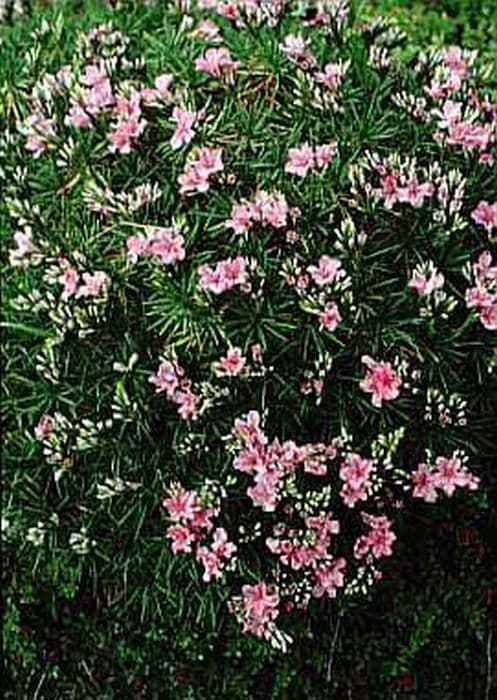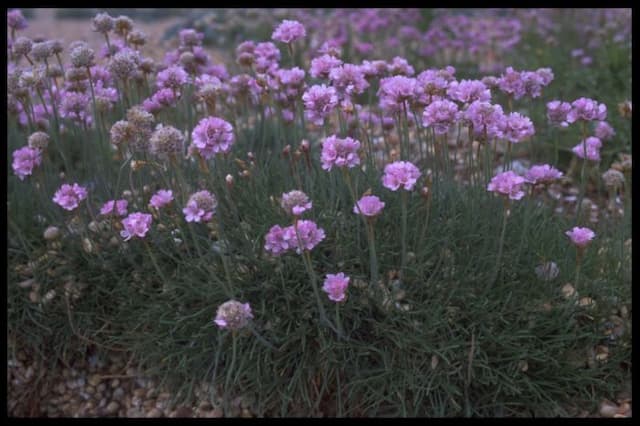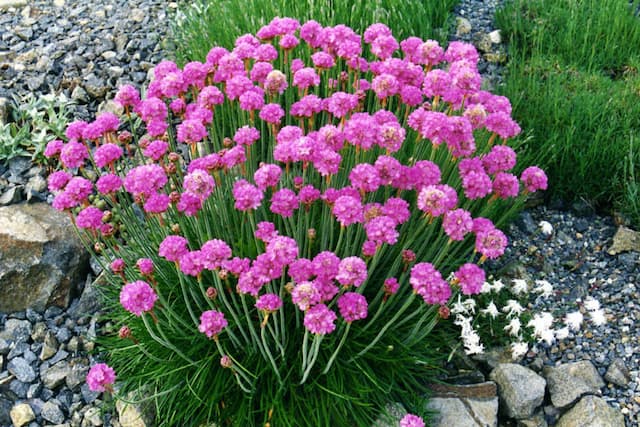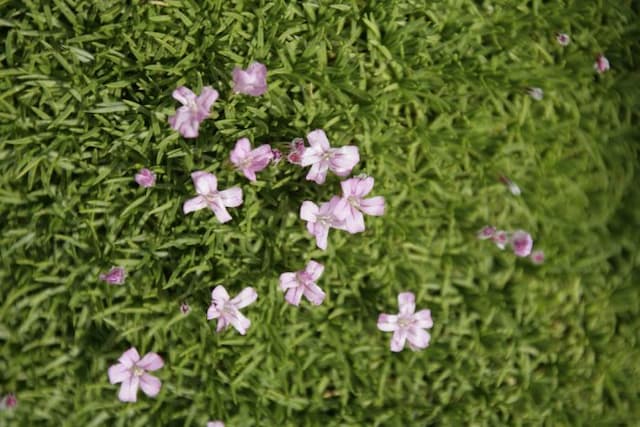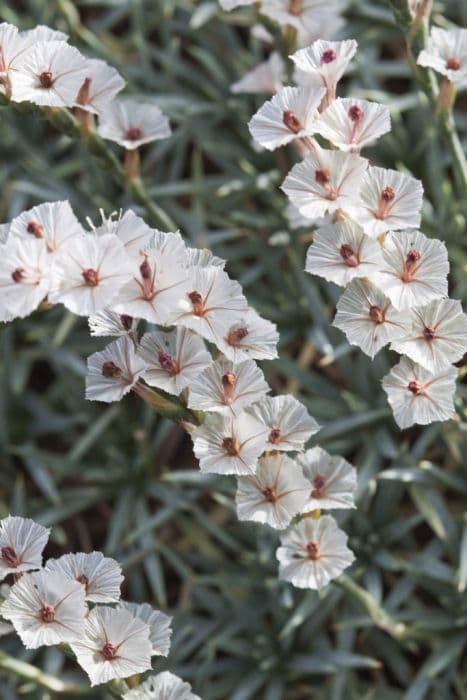Sea Lavender Limonium platyphyllum

ABOUT
The plant commonly known as sea lavender features a rosette of spoon-shaped leaves that are leathery in texture and might bear a slight silver-green coloration. On top of its foliage rise stiff, wiry stems which bear clusters of tiny, delicate flowers. The overall appearance of the flower clusters can be likened to a cloud or a mist, with each individual flower presenting a papery texture and commonly found in shades of lavender, violet, purple, and sometimes white. As the plant matures, the flowers can persist, drying on the stem and retaining their shape and color, which makes sea lavender a popular choice for dried flower arrangements. The visual effect of this plant in full bloom is a subtle and soft display of color that stands out against the contrasting green of its foliage.
About this plant
 Names
NamesFamily
Plumbaginaceae
Synonyms
Sea Lavender, Statice, Marsh Rosemary
Common names
Limonium meyeri, Statice meyeri, Limonium caspium.
 Toxicity
ToxicityTo humans
Sea Lavender, or Limonium platyphyllum, is not known to be toxic to humans. There is no clear evidence or documentation about its toxicity if ingested, and it does not commonly cause poisoning symptoms. However, as with any plant not typically used for consumption, ingesting Sea Lavender may potentially cause gastrointestinal discomfort or an allergic reaction in some individuals.
To pets
Sea Lavender is also not known to be toxic to pets. There is no substantial information to suggest that it would cause any significant symptoms of poisoning in animals such as dogs and cats if they were to ingest it. However, ingestion of non-food plants can sometimes result in mild gastrointestinal upset in pets, and individual animals may have allergies or sensitivities.
 Characteristics
CharacteristicsLife cycle
Perennials
Foliage type
Deciduous
Color of leaves
Green
Flower color
Blue
Height
1-2 feet (30-60 cm)
Spread
1-2 feet (30-60 cm)
Plant type
Herb
Hardiness zones
4
Native area
Asia
Benefits
 General Benefits
General Benefits- Limonium platyphyllum, commonly known as sea lavender, adds aesthetic value to gardens with its showy and long-lasting purple flowers.
- Sea lavender is drought-tolerant, making it suitable for xeriscaping and sustainable landscaping in dry climates.
- With its ability to tolerate salt spray and saline soils, sea lavender is ideal for coastal gardens.
- Sea lavender attracts pollinators like bees and butterflies, supporting local ecosystems and biodiversity.
- It is low maintenance, requiring minimal watering and care once established, thereby reducing gardening efforts.
- Sea lavender's resistance to many pests and diseases keeps gardening environmentally friendly by reducing the need for chemical interventions.
- Its widespread use in dried flower arrangements provides a lasting decoration and the potential for small-scale economic activity if commercially cultivated.
- Sea lavender has a robust root system that can help with soil stabilization in areas prone to erosion.
 Medical Properties
Medical PropertiesThis plant is not used for medical purposes.
 Air-purifying Qualities
Air-purifying QualitiesThis plant is not specifically known for air purifying qualities.
 Other Uses
Other Uses- Sea lavender is often used in dried floral arrangements because it retains its color and shape well after drying.
- The plant is sometimes planted in coastal areas to help stabilize sand dunes and control erosion.
- With its tolerance for saline soils, sea lavender can be used in landscaping as a salt-tolerant ornamental plant.
- The plant's dense growth habit makes it a suitable choice for ground cover in large, sunny gardens where other plants might struggle.
- Its long-lasting blooms make sea lavender a popular choice for fresh flower arrangements, adding a splash of color to bouquets.
- In some cultures, sea lavender is used in traditional ceremonies or placed in homes as a symbol of remembrance.
- The striking appearance of the plant can be used for photographic purposes, serving as an attractive subject for nature photography.
- Sea lavender is occasionally used in educational settings, such as botanical gardens, to teach about plant adaptation to challenging environments like high salinity.
- Gardeners might use the plant as a border species due to its mounding habit and vibrant colors, defining edges or pathways.
- Some artisans use the dyed or natural stems and flowers of sea lavender in crafting activities such as wreath making and decoration.
Interesting Facts
 Feng Shui
Feng ShuiThe Sea Lavender is not used in Feng Shui practice.
 Zodiac Sign Compitability
Zodiac Sign CompitabilityThe Sea Lavender is not used in astrology practice.
 Plant Symbolism
Plant Symbolism- Remembrance: Limonium platyphyllum, also known as Sea Lavender, is often associated with remembrance, making it a common flower choice for sympathy arrangements and memorials.
- Success: Sea Lavender can symbolize success and the achievement of goals, perhaps because of its hardy nature and the way it thrives in challenging environments.
- Beauty: With its delicate and colorful appearance, Sea Lavender represents beauty and is often used to convey admiration for someone's beauty and grace.
- Longevity: The plant's ability to retain its color and shape when dried makes it a symbol of longevity and everlasting life.
 Water
WaterSea Lavender (Limonium platyphyllum) thrives with consistent moisture but should never be left in standing water. Aim to water this plant deeply once a week, allowing the soil to dry out slightly between waterings. During hotter periods, especially in summer, you may need to increase the frequency to every few days. However, during the winter or cooler months, reduce watering to every two weeks or when the soil feels dry to the touch. As a guideline, provide approximately half a gallon of water for an average-sized plant each time you water, adjusting the amount based on the plant size and environmental conditions.
 Light
LightSea Lavender prefers full sunlight to thrive, ensuring bright, direct light for the majority of the day. A spot that receives at least 6 to 8 hours of direct sunlight is ideal. Avoid placing it in full shade as this can lead to poor flowering and leggy growth.
 Temperature
TemperatureSea Lavender is quite tolerant of a range of temperatures, but it grows best in conditions between 60°F and 80°F. It can survive minimal frosts but should be protected from temperatures below 30°F. During extreme heat, above 90°F, provide some afternoon shade to prevent overheating.
 Pruning
PruningSea Lavender should be pruned to remove spent flower stalks and encourage further blooming. This is best done immediately after a flush of bloom declines, which can be multiple times throughout the summer and fall. Lightly shaping the plant can also promote a denser, more attractive growth habit. Prune back to the basal foliage after the flowering season ends to maintain plant health and appearance.
 Cleaning
CleaningAs needed
 Soil
SoilSea lavender thrives in well-draining, sandy soil with slight alkalinity, a pH of around 7.5 to 8.5. A mix of one part sand, one part garden soil, and one part peat or compost is ideal to provide the necessary drainage and nutrients.
 Repotting
RepottingSea lavender should be repotted every two to three years to refresh the soil and encourage growth. It is important not to damage the root system during repotting as the plant prefers minimal root disturbance.
 Humidity & Misting
Humidity & MistingSea lavender tolerates a wide range of humidity levels but does best in moderate conditions. Ensure good air circulation around the plant to prevent moisture accumulation which can lead to fungal issues.
 Suitable locations
Suitable locationsIndoor
Place sea lavender in bright light, slightly dry soil.
Outdoor
Full sun, well-draining soil, protect from winter wetness.
Hardiness zone
4-8 USDA
 Life cycle
Life cycleLimonium platyphyllum, commonly known as sea lavender, starts its life cycle from a seed, which germinates into a small seedling when conditions of moisture and temperature are favorable. As it grows, the plant develops a basal rosette of broad, leathery leaves during its vegetative stage. The sea lavender then enters its flowering stage, usually in the summer, producing tall, branching stems topped with clusters of tiny flowers ranging from white to pink and violet. After pollination, which is often aided by insects, the plant sets seeds that are dispersed by wind or water. These seeds enter a period of dormancy, waiting for the right conditions to germinate and start a new life cycle. Over the course of their life, which can extend for several years, sea lavenders may undergo multiple flowering and seeding phases, particularly in favorable growing conditions.
 Propogation
PropogationPropogation time
Spring-summer
Limonium platyphyllum, commonly known as Sea Lavender, is typically propagated by seed. The ideal time to sow Sea Lavender seeds is in late winter to early spring, ensuring that the conditions are right for seed germination. To propagate by seed, one should sprinkle the tiny seeds onto a well-draining seed starting mix and gently press them into the surface, ensuring they are not buried deeply as they require light to germinate. Maintaining the soil's moisture and keeping the temperature around 70 degrees Fahrenheit (around 21 degrees Celsius) will aid in germination, which should occur within 2 to 3 weeks. After seedlings have developed a few sets of true leaves, they can be transplanted into their final growing position where they can enjoy full sun to partial shade.


